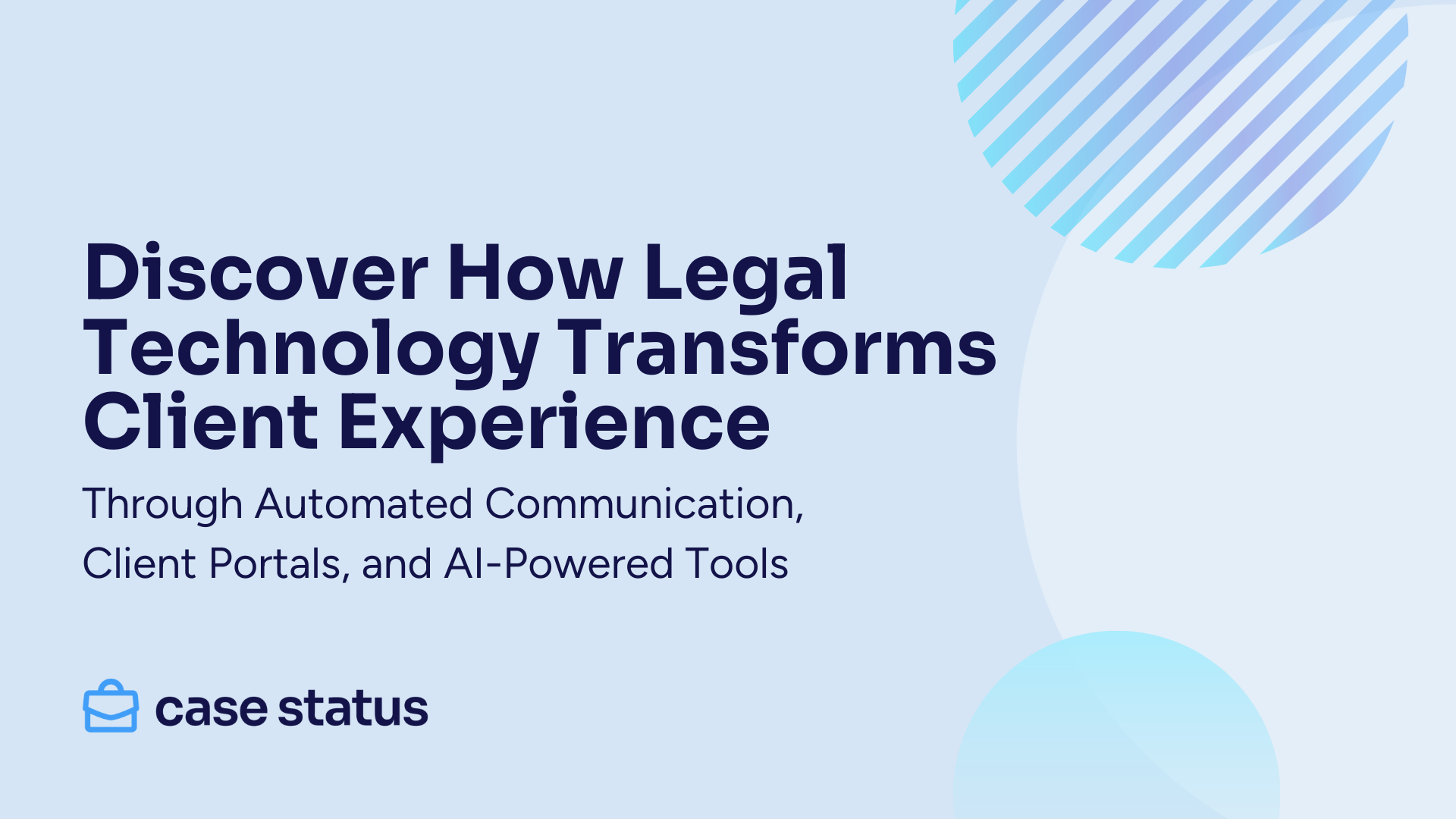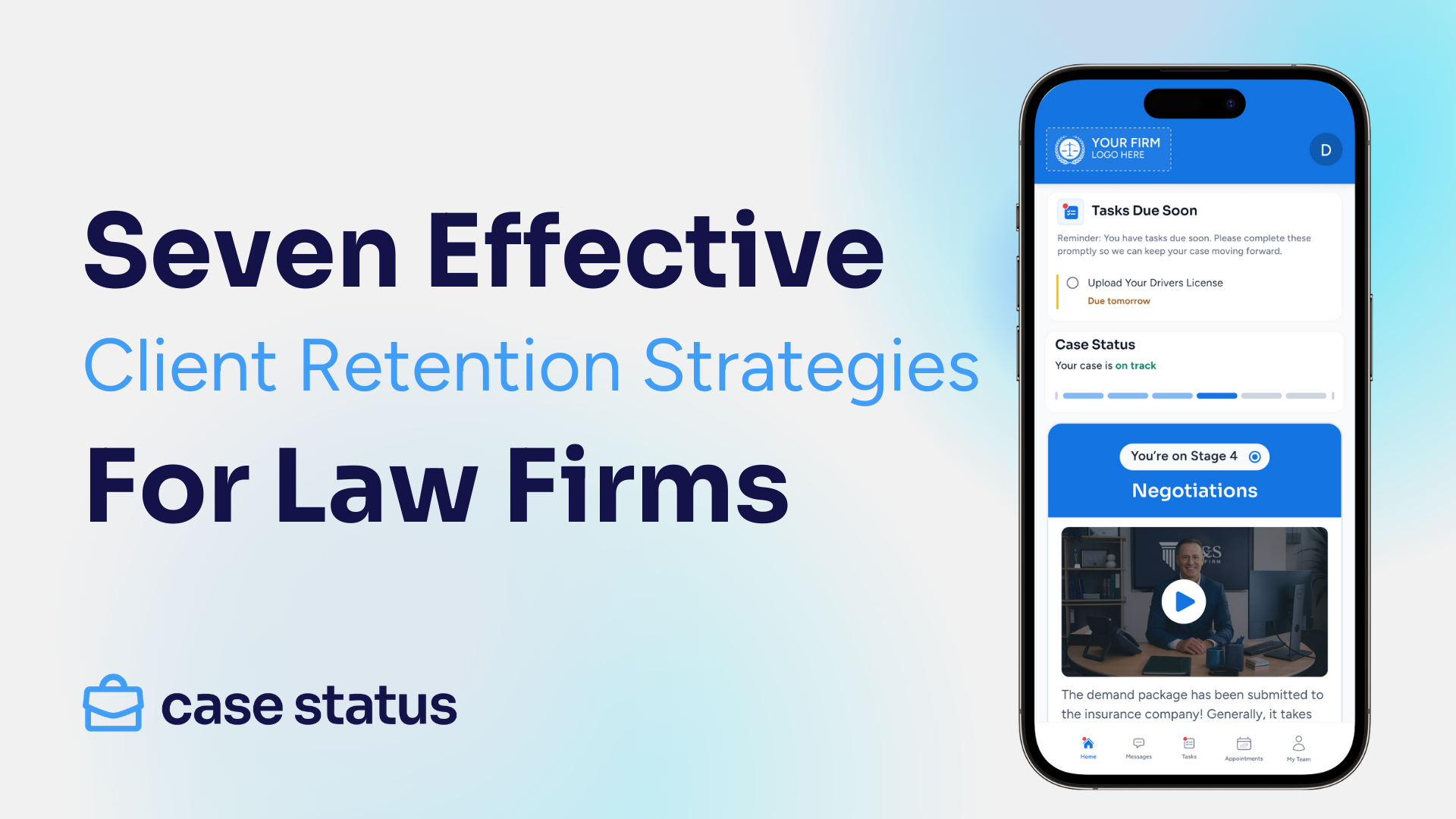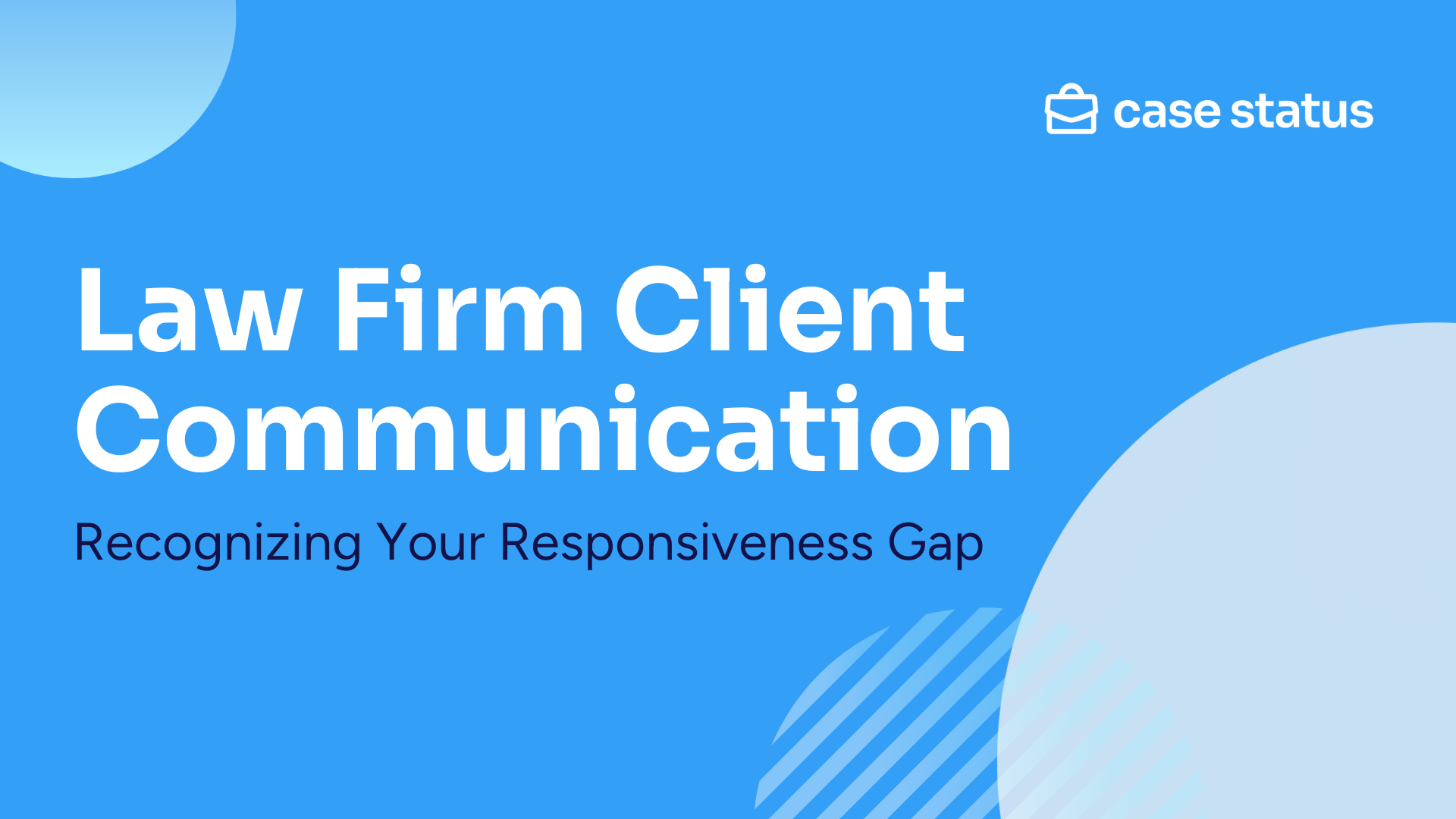
Clients now expect the same transparency from their law firm that they get from everyday apps like Uber or Amazon: real-time status, quick replies, and a clear sense of “what happens next.”
When calls go unanswered or emails linger, trust slips, and so do referrals.
Our 2025 Legal Client Experience Report findings show why: only 9% of firms offer a self-service mobile app, yet firms that move routine updates into a mobile client portal see 80%+ client adoption and reclaim ~1,300 hours/year via automation, without adding headcount.
Thoughtful and predictable communication is now operational table stakes. One in four clients reports anxiety from not knowing what’s happening; yet only ~35% of firms measure response time. Firms that target a 5–6 hour median response see satisfaction (NPS) rise, because you’re not hoping clients are happy, you’re knowing and adjusting quickly.
If you're mapping out firm operations, remember: Client experience (CX) and workflows are inseparable. A mobile portal for updates, automation for routine tasks, and AI-assisted messaging reduce busywork and raise client confidence.
Want a quick baseline before you dive in? Try these simple calculators to see how communication speed and case economics affect outcomes:
Leverage a Client Communication Portal for Consistent Updates
When updates live in voicemails and email inboxes, anxious clients keep calling for answers, and your team spends hours repeating the same information. With a client communication portal, clients can instantly view case milestones, messages, and documents.
Further, with a mobile client portal for law firms, firms see higher engagement. Case Status data from the Legal CX Report shows that only 9% of firms offer a self-service app.
However, after moving routine communications into the app, our data shows adoption rates top 80%. This results in firms reporting:
- 30% fewer calls.
- 90% fewer client emails.
- 130% increase in NPS.
For many firms, that reduction in manual communication equates to tangible ROI. For example, an 80% drop in back-and-forth messages can save a 20-person team nearly $500K annually, while NPS lifts from 20 to 80+ often translate to 20 or more new referral cases per year (~$200K in revenue). Faster updates also accelerate collections, improving cash flow by as much as $300K annually.
If you're comparing options, this overview of the best client portals for law firms explains why app-based experiences can outperform traditional web portals on engagement and time saved.
What changes with a modern portal:
- 24/7 visibility. Clients track filings, appointments, and next steps whenever they need to; no “just checking in” messages.
- One secure thread. Messages and files reside in a single, encrypted channel tied to the matter, ensuring nothing gets lost.
- Faster follow-through. Event-based nudges, like signature needed and hearing confirmed, go out automatically and are easy to act on, cutting delays and staff rework.
- Client Intelligence AI. Beyond updates, AI surfaces message urgency and sentiment signals, so staff can prioritize outreach, step in early on at-risk clients, and keep satisfaction trending upward without manual monitoring.
For fundamentals and use cases, see what a client portal is used for.
Automate Consistent & Daily Administrative Tasks
When team members are handcrafting reminders, chasing signatures, and rescheduling appointments, the day disappears into admin work. With automation, routine work fires based on case stage, freeing your team to focus on strategy, negotiation, and client care.
Here's what that shift looks like in practice:
- Stage-based status updates. As soon as a matter moves from “intake” to “retained,” clients receive a welcome message, the retainer, and next-step checklists. When discovery closes or mediation is set, the system pushes a plain-language update automatically.
- Smart appointment reminders. Court dates and consultations trigger reminders at 14-day, 7-day, and 24-hour intervals — or at custom intervals your firm chooses — with directions, links, and required documents.
- Document requests that complete themselves. If proof of treatment or pay stubs aren't uploaded within three days, clients get a gentle nudge; after seven days, the task escalates to a case manager. The checklist stays current without inbox ping-pong.
- E-signature and payments on cue. Case Status sends timely reminders and triggers when retainers, authorizations, or settlement agreements are ready, so your existing e-signature and billing tools can take over seamlessly. Cash flow improves, and collections take fewer touches.
- “No-update” updates. In quiet phases, scheduled touchpoints reassure clients that the case is on track and outline what the team is waiting on. This helps prevent anxious “just checking in” calls.
- Automatic feedback prompts. After key milestones, clients are asked (once) for quick feedback, giving you a live read on satisfaction without manual surveys.
If you're mapping this across the firm, start with one high-friction workflow and expand. A system designed to scale client services with automation lets you configure triggers without IT tickets, so improvements stick.
For a broader perspective on tying automation to intake, scheduling, communications, and outcomes, see our guide to law firm workflow management.
Use AI for Proactive Client Communication
Manually drafting emails eats hours, and the tone can vary wildly by sender. AI changes that. Trained on your firm's data and voice, it produces clear, on-brand messages in seconds, so routine updates go out promptly and consistently while attorneys focus on legal work.
Case Status data from the Legal Client Experience Report found that firms utilizing software and AI for communication report more than 1,300 hours saved per year, thanks to faster responses and automated follow-through.
Here's how to put AI to work without losing your professional touch:
- Recommended Responses. Suggested replies that sound like your firm. AI learns from prior messages and guidelines to draft responses that match your tone, whether that's professional, plain language, or simply client-friendly. Attorneys review and send in a few clicks, cutting reply time from minutes to seconds.
- On-brand updates, done on time. AI-assisted templates acknowledge lulls in cases, restate what you’re waiting on, and set the next check-in date, keeping your response times near the 5 to 6-hour benchmark tied to higher NPS.
- AI case summaries. Long message threads and bulky uploads become concise briefs your team can scan before a call or hearing, reducing meetings and rework.
- Built-in translation. Clients can communicate in their preferred language, and AI automatically translates messages both ways in the portal. This improves clarity and trust for multilingual clients.
- Predictive NPS. AI forecasts client satisfaction trends and flags at-risk relationships early, so staff can intercept problems before they escalate and turn potential complaints into loyalty.
- Guardrails by design. Keep a human in the loop for final send, store approved templates centrally, and run AI inside secure, audited systems (SOC 2 / HIPAA / GDPR posture) rather than consumer tools. It’s how you move faster and stay compliant.
Want practical starting points? See AI legal prompts for your day-to-day work for prompt patterns that produce reliable drafts, and explore AI for effective client communication to tailor AI to your firm's voice and workflows.
Consistently Measure Client Satisfaction & Experience
Reactive firms learn about problems only after a complaint or a lost client. Proactive firms always build feedback into their workflows, so they know how clients feel at key moments and can act immediately.
Automation ensures every client is invited to provide feedback, drastically reducing the need for spreadsheets and manual reminders.
From ‘Hoping' to ‘Knowing' in Real Time
Our data shows that anxiety often stems from not knowing what's happening: 1 in 4 clients reports case-related anxiety tied to poor communication. Avoid this with proactive steps:
- Send prompts based on milestones. Send a one-question check-in immediately after an update is released. If a client response signals frustration, route an alert to the case manager for same-day follow-up.
- Act on detractors within 24 hours. Create a simple playbook: acknowledge, clarify, give the next step, and schedule a follow-up. Fast recovery protects trust and prevents negative reviews.
- Use sentiment signals to prioritize outreach. Case Status Predictive NPS predicts client satisfaction trends and flags at-risk relationships without requiring manual surveys. This allows staff to intercept problems early, turn potential complaints into loyalty, and generate more referrals.
Case Status's NPS feedback tracker for legal client services centralizes scores and comments so your team can respond quickly.
What to Track (and Why It Helps)
Building feedback into daily operations turns guesswork into a clear, continuous read on client experience, and gives your team the insight to fix issues before they become complaints.
- NPS over time. Tracking NPS reveals whether clients feel cared for at each stage, not just at the end. Use the quick tool to calculate client satisfaction and model improvements.
- Response time. Faster replies correlate with higher satisfaction; firms aiming for the 5-6-hour benchmark see better NPS.
- Engagement signals. App logins, read receipts, and message replies show whether updates are reaching clients or if a different approach is needed. Firms that adopt modern CX tools (like a mobile app) see far higher engagement than traditional web portals.
For a leadership perspective on tying these pieces together, see our guide on how to manage a law firm.
Why Legal Technology Will Make Your Life Easier
Great client experience is an operational choice. Firms that pair transparent processes with the right tools spend less time chasing paperwork and more time practicing law.
Here's the bottom line:
- CX differentiates. Real-time updates and plain-language messaging turn anxious check-ins into informed clients who stick with you and refer others.
- Tools cut the busywork. Automation handles reminders, signatures, and routine status updates, allowing your team to focus on strategy and outcomes.
- Transparency builds trust. Consistent, on-brand communication backed by secure, auditable systems demonstrates to clients that you're organized and in control.
- Discipline makes it durable. A small set of well-chosen workflows, periodic training, and regular measurement (response times, satisfaction) keep improvements compounding.
- Ethics and security first. Adopt safeguards by design with permissions, encryption, and audit logs, so efficiency never compromises professional duty.
- Referrals fuel growth. Happy clients talk, and Case Status makes sure their voices are heard. Scale smarter, boost revenue, and turn satisfaction into your strongest growth engine.
Done thoughtfully, legal tech doesn't add another tool to manage. It simplifies the way your firm already works and raises the standard of service clients feel every day.



.png)